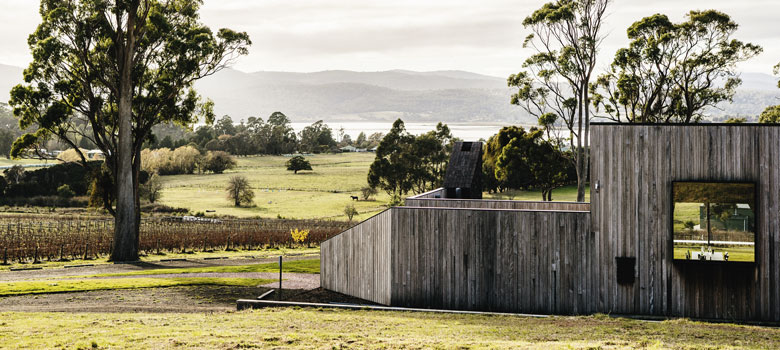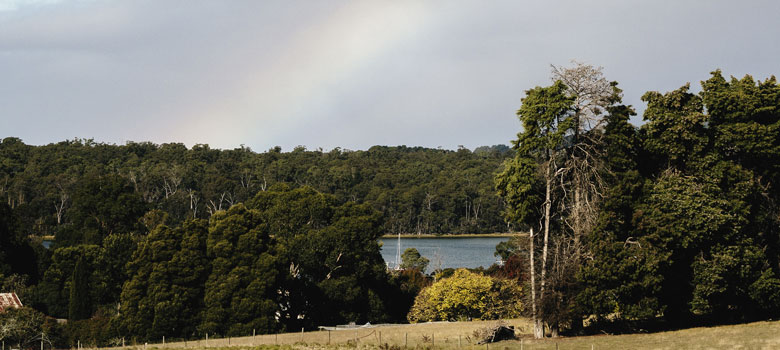
Wine
Holyman's Stoney Rise
On the western bank of Tasmania’s Tamar River, a passionate wine couple are quietly going about doing big things in a small way. Some things just click. Like Nicole and Keith, lamb and rosemary, Posh and Becks, some things are just meant to be.
When it comes to that ‘click’ and wine, the term terroir is used to explain the marriage of place, vine and season. It’s an ethereal, 3D concept that encapsulates the ever-active components of soil, sun, grape variety, weather, etc., and how they all connect to create an amalgam of aromas, textures and flavours distinct to that place and that time.
There has been much study done on this concept, and whilst initially Australians were reticent to embrace the notion of terroir, we now mostly agree that quality wine can express its home better than a collection of words, a photo or even a painting could ever hope to.
But grapes can’t pick themselves, so what about the human part of this equation? Surely, the people who tend to earth and vine then shepherd the fruit from the vintage to the bottle are significant, if not equal, contributors?

Above: A hint of a Tamar River rainbow.
Not much study has been done on the human addition to terroir, but if there were, Joe and Lou Holyman of Tasmania’s Stoney Rise would be a beautiful study of how place, vine and people come together to create graceful, unpretentious serendipity.
Stoney Rise is perched above the banks of lutruwita or Gravelly Beach, 25 minutes north of Launceston on the west bank of the kanamaluka, the traditional name of the Tamar River. But the brand began in 2000 whilst Joe was working vintage at Cape Jaffa on South Australia’s Limestone Coast.
It was at Cape Jaffa that Joe and Lou met, fell in love and made plans to move back to Tasmania to focus on Pinot Noir and Chardonnay. They did so in 2004, married and purchased Rotherhythe, a property that had Pinot Noir, Chardonnay and Cabernet. They pulled out the Cabernet, planted more Pinot and added Grüner Veltliner, and Trousseau a little later. Having built a small winery in 2008, they eventually recreated their cellar door in 2020.
Full Circle
For Joe, the move back to Tasmania represented a homecoming, figuratively and literally. “My family goes back about 175 years in Launceston and I was brought up on a little property on the other side of the kanamaluka (Tamar),” Joe recalls. “Dad had planted some hobby vines and school holidays were spent in the vineyard. Through his business, Dad had developed quite a cellar, and Mum had a catering business, so from a young age, food and wine were always around.”
“I was introduced to wine as something you had with food. Dad was buying imported wine and every time he opened one, I got to taste it and then had to grab a book and read all about it.
“For a long time, I didn’t know what I wanted to do,” explains Joe. “I was ok at cricket and the deal I had with my father at the time was that if I got my HSC, I could go to England and play a season on the proviso that when I got back, I went to university.”
On his return, he was only at uni for about six weeks when he got an offer to play cricket in Hobart. Joe played nine Shield games as wicket keeper for Tasmania and took a record seven catches on his debut innings. At the same time he was studying the associate diploma of wine marketing at Roseworthy, which led to work as a sales rep.
“The wine industry kind of just grabbed me,” Joe explains. “I got to meet Peter Lehmann, Peter Barry and Bob McLean and through those guys the wine world looked pretty entertaining.”
Joe eventually decided to experience the winemaking side of the business and after travelling around the world doing vintages and learning about viticulture and production, ended up at Cape Jaffa. Joe bought some fruit to make some wine for fun and Stoney Rise was born.
Liquid Polaroids
Joe and Lou’s Pinot Noirs and Chardonnays reflect a lo-fi, minimalist approach to winemaking. Joe spends as little time as possible in the winery, and as much time as possible in the vineyard in an attempt to shepherd as much site, vineyard and varietal character as possible into the bottle.
They exercise biodynamic practices as a quiet matter of principle, not a marketing badge and for an untrained winemaker whose work is driven by experience, the results, especially across the Holyman wines, are splendid and distinct.
Left: Joe and Wine Selectors’ Matt White share a joke. Right: Tasty tasting snacks at Stoney Rise cellar door.
“When I talk about my or our wine, I talk about it in relation to where we live, the land that we look after,” Joe explains. “I try to express the seasons as much as we possibly can, but I don’t have to do too much because I grow nice grapes.”
“The grapes have everything in them and the more you work them, the less of the place comes through,” he continues, “and even if you don’t add anything, or even press the fruit too hard, you are essentially taking out the sense of place.”
Joe and Lou’s wines are liquid polaroids of their place, and to get a closer look, they hosted Selector for a tasting of the Pinot Noir and Chardonnay across the Holyman and Stoney Rise ranges.
Wines of Place and Purpose
Starting with Holyman Chardonnay stretching back 16 years to 2005, these wines are defined by their elegance; pure, rich layers of apples, peaches, pears and grapefruits that have natural power but without the weight. The younger 2012-2018 wines show flinty aromatic characters, fine lines of fruit driven by firm but delicate acidity. The older wines are showing variances of baked apples, cream and aromatic white flowers.
Left: Lou Holyman on Chardonnay duty; Right: Holyman Chardonnay flights.
Favourites were the 2010 for its freshness, the 2012 for its sweet rounded fruit expression and the 2015 for its mix of complexity and intensity.
Stoney Rise Pinot Noir followed, and at around $30 a bottle, it’s hard to argue against this being the best value Pinot in Australia. Even way back to 2007, the wines display what high quality, and often highly priced, Pinot Noir is all about: fine, delicate and elegant fruit, wrapped in a concentrated package and appended with heady, perfumed aromatics. Overall favourites were the 2015 for its fresh rhubarb and cherries and soft mouthfeel, the 2013 for its strawberry and black cherry concentration and the 2011 for its creamy mouthfeel. It’s little wonder these wines are hard to get your hands on.
Holyman Pinot Noir
Taking a step up in concentration and detail are the flag-bearing Holyman Pinot Noirs. Defined by concentration, detail and depth, it is in these wines that the argument for a human corner in the terroir equation becomes hard to ignore. So much definition is carried in these wines, yet somehow the weight of the wines remains unaffected. Delicate, elegant and sometimes exotic layers of strawberries, all manner of cherries and spices combine with broody, earthy aromatics delivered with restraint. Standouts were 2010 and 2012 for their Burgundian concentration and the 2015 for its fine, earthy elegance.
Left: Joe Holyman with the Project X line-up; Right: Pinot Noir pourings
Lastly came Project X. Started as an experiment, these wines are all made using 100% whole bunch and 100% new oak – a brave move not many would attempt. However, the results are magical. All the oak and bunch character is in the background and manifests as seasonings to the delicate, tighly wound lines of strawberry, raspberry, rhubarb, blueberries, Campari and cranberry. The palate is long and the mouthfeel is framed with bright acidic lines that will make them long term cellar prospects. The 2016 was the standout for its purity, concentration and natural mouthfeel.
With Stoney Rise, Joe and Lou have created something so special that it is hard to imagine its wines coming from anywhere else. Their wines not only define who they are and what they believe in as a couple, but the state they live in, and their slice of the Tamar. If that is not a strong case for human influence on terroir, it’s hard to know what would be.